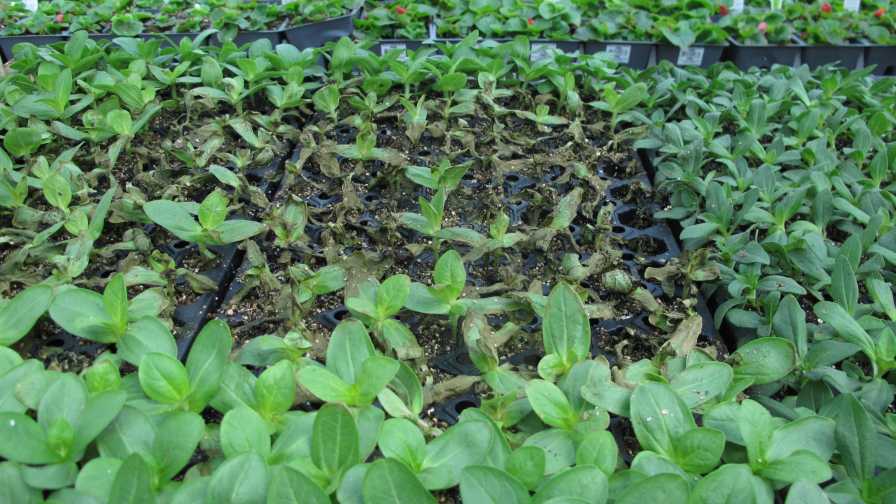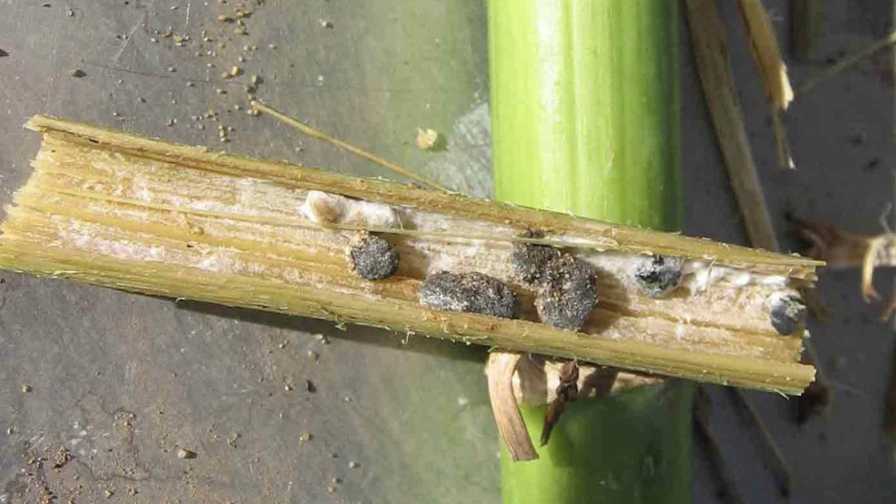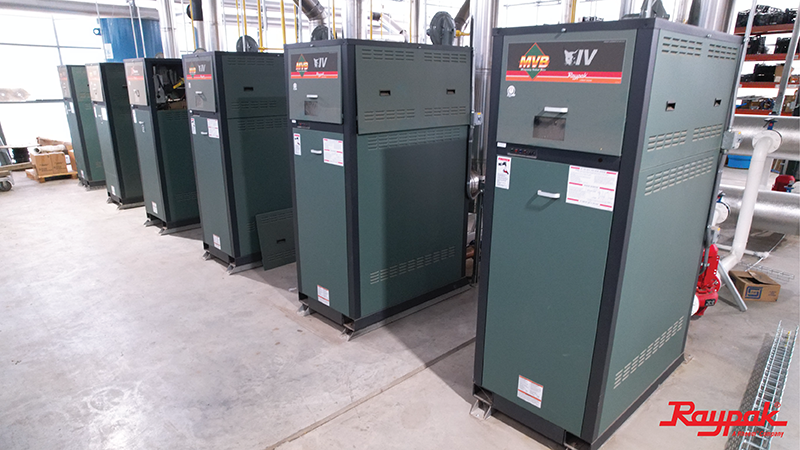Tips on Keeping Greenhouse Seed Pathogen-Free

Seedborne pathogens like Rhizoctonia can cause havoc in your young plantings.
Photo by Janna Beckerman
There is something fundamental about sowing seed. It is a central process to many greenhouses, regardless of the sophistication of the operation. It is something that humans have done for thousands of years.
Unfortunately, the planting of seeds carries with it the risk of transport and spread of many plant pathogens. In fact, several hundred common pathogens of greenhouse crops are seedborne. These pathogens are spread by:
- Seed contaminated by seed-related detritus (e.g., seed pods, husks, leaves, and even sclerotia
- Seeds contaminated with superficial surface contact with bacteria, hyphae, or spores, and
- Seeds that possess latent infections of the endosperm or embryo.
These seedborne pathogens can infect the seedling and then spread to neighboring plants, resulting in significant crop and financial loss, and greater use of fungicides to protect these crops.
Pathogen-Free Is Not Guaranteed
Buying high-quality seed is the most cost-effective means to minimize the risk of seedborne pathogens. Unfortunately, certification does not guarantee that seed is free from all disease; instead, it means it has met the standards of the certification agency, often for specific pathogens but not every pathogen.
But what exactly are the risks we are trying to manage? In a study in England1, more than half (55%) of the seed tested were found to be free of pathogens that might cause disease in these species. When a pathogen was found, recovery was as high as almost 25% for Alternaria spp. on 10 ornamental crops to as low as 3% of seed lots tested for Fusarium capable of infecting two ornamental crops.
In addition to the fungal and pseudofungal pathogens of Phoma and Pythium, bacteria (species of Pseudomonas or Xanthomonas), were also recovered. These numbers seem low, but how many of you would be willing to eat a bag of 50 M&Ms with a rotten one in it? What if there were 12 rotten ones? Most of us would pay a few cents extra to make sure we didn’t have any rotten ones, and that the M&Ms were produced recently, and not in in 2015! Buying the cheapest seed is often a pennywise endeavor that results in pounds of regret.

Sclerotia can pass through screens along with larger seed like sunflower and infect the next crop.
Photo by Janna Beckerman
Control Options
Currently in the U.S., 42-S Thiram is the only fungicide labeled for treatment of flower seeds. Thiram gave an 80% reduction in seedborne anthracnose in a relative of the ornamental lupine. The rate of 8 fluid ounces (fl. oz.) per 100 pounds of seed results in using slightly less than 0.5 teaspoon thiram per pound of seed. Treatments should not be applied to: 1) pelleted seed, 2) previously treated seed, or 3) old- or poor-quality seed. Keep in mind that treated seeds, bulbs, and corms are hazardous to fish, birds, and mammals, and need to be planted and not broadcast on the soil surface. Also, note that thiram would not be effective against Pythium, Phytophthora, or downy mildews.
Hot water can be used to sanitize seeds of certain pathogens. When performed properly, hot-water treatment can kill bacteria inside as well as on the outside of seed. Because it is difficult and impractical for some seed types, hot water treatment has limited use, but for more information see Small-Scale Cost-Effective Hot Water Seed Treatment. Other treatments using steam or microwaves provided inconsistent results or greatly reduced seed viability, and should probably be avoided.
Commercial disinfectants are another option for use as seed treatments. Several are specifically approved for this purpose, and include KleenGrow, ZeroTol 2.0, or Oxidate 2.0, to name but a few disinfectants that are specifically labeled for use on seed. Of course, chlorine bleach can also be used to disinfect seed. Bleach is less lethal than hot water for most pathogens; however, bleach is only effective against pathogens on the seed surface. Some formulations of Clorox brand bleach (NaOCl concentrations at 7.85% and 5.84%) are labeled for seed treatment.
To use Clorox to treat seed, a concentration of 10,000 ppm of chlorine is used to treat seeds. To achieve this, use 16.7 fl. oz. of the 7.85% formulation or 22.2 fl oz. of the 5.84% and bring up to 1 gallon of water. One gallon of solution is sufficient to treat 1 pound of seed. Enclose seed in cheesecloth, submerge, and agitate for 40 minutes. Rinse seed under running tap water for five minutes, then dry seed thoroughly on paper towels.
Place dry, disinfected seed in a new envelope. Soaking can stimulate germination, so plant seeds promptly. A fresh 1-gallon solution should be used for each treatment; bleach oxidizes in a few hours and will not be effective within a few hours of preparation.
1. For more information see: O’Neill et al. 2010. Seed-borne diseases of ornamentals: prevalence and control. Factsheet 17/09 Protected Ornamentals Project No. PC 252. Available at: https://projectblue.blob.core.windows.net/media/Default/Horticulture/Publications/Seed-borne%20diseases%20of%20ornamentals%20prevalence%20and%20control.pdf

Early smut symptoms on greenhouse-grown blanketflower and hepaticum.
Photo by Janna Beckerman
How Pathogens Spread
The table below describes the three main ways seedborne pathogens are spread. There are three potential sources:
- Seed contaminated by seed-related detritus
- Seeds contaminated with superficial surface contact with bacteria, hyphae, or spores
- Seeds that possess latent infections of the endosperm or embryo.
Note that this simply identifies the potential hazard; the risk of the infection varies between seed/plant, pathogen, and environment.
|
Disease |
Pathogen |
Common Hosts |
Source |
| Alternaria | Alternaria spp. | Snapdragon, cyclamen | 1,2,3 |
| Anthracnose | Colletotrichum spp. | Cyclamen, lupine, Vinca minor | 1,2 |
| Downy mildew | Peronospora and Plasmopara spp. | Basil, flowering kale, impatiens, sunflower, tobacco | 1,2,3
|
| Fusarium wilt | Different special forms of Fusarium oxysporum | Basil, carnation, cyclamen, lisianthus, lupine, marigold, stock | 1,2,3 |
| Grey mold | Botrytis cinerea | Most greenhouse plants | 1,2,3
|
| Ramularia leaf spot
|
Ramularia spp. | Pansy, primula, veronica | 1,2 |
| Rhizoctonia | Rhizoctonia solani | Impatiens, zinnia | 1,2 |
| Rust | Puccinia spp., other rust genera | Hollyhock, snapdragon, | 1,2 |
| Septoria leaf spot | Septoria spp. | Black-eyed Susan, salvia, veronica, zinnia | 1,2, |
| Smut (Fig. 2)
|
Entyloma spp., Tilletia | Blanketflower, coneflower, lobelia ornamental grasses, hepaticum | 1,2,3 |
| White mold | Sclerotinia sclerotiorum | Sunflower, sweet pea | 1 |
| Seedborne Pathogens—Bacteria | |||
| Bacterial Leaf Spot | Xanthomonas spp. | Alyssum, annual geranium, salvia, zinnia | 1,2,3 |
| Bacterial Wilt | Pseudomonas spp. | Annual geranium, salvia | 1,2,3 |
| Rhodococcus | Rhodococcus spp. | Consult reference in footnote 2 for comprehensive list | 1,2 |










